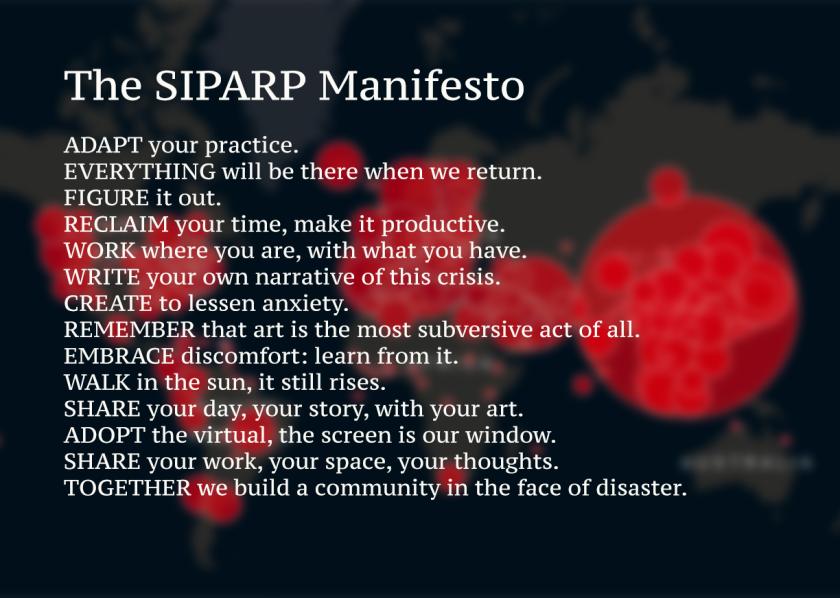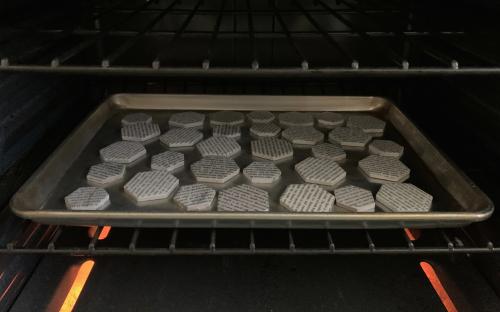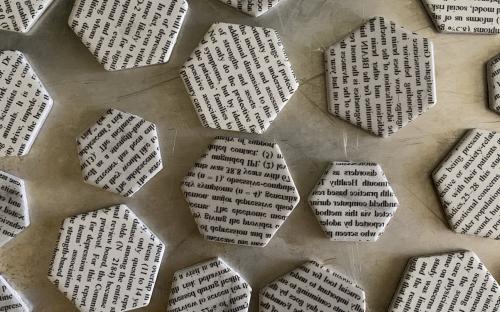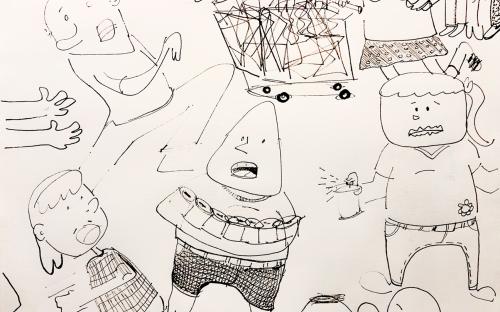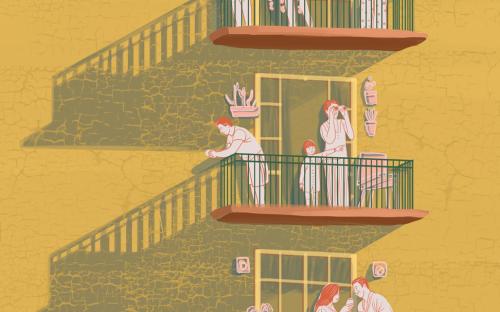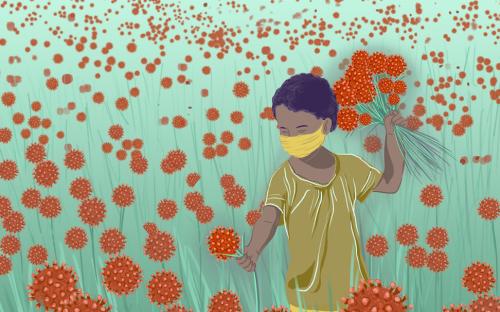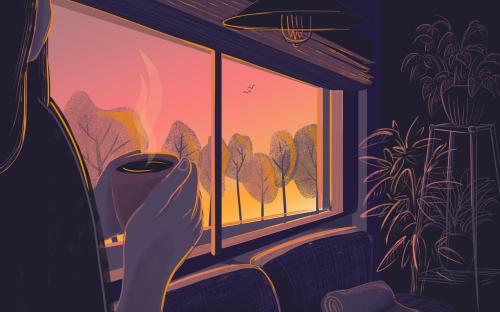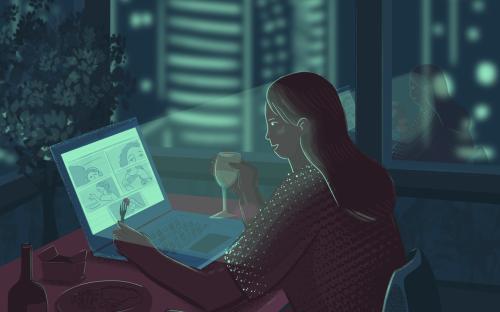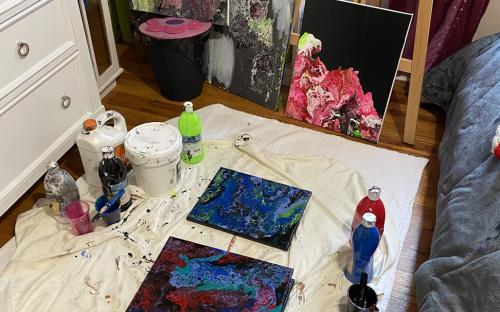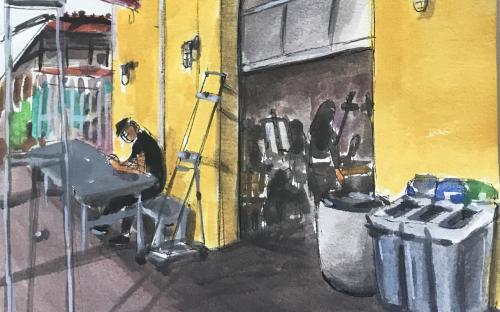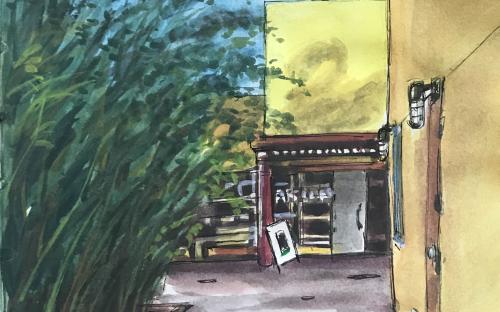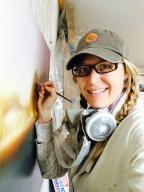 “Everything will be there when we return.” Professor of painting Samantha Fields repeats it these days like a mantra, as much to herself as to her students. It is a central tenet of the manifesto she wrote for her new Self-Isolation Pandemic Artist’s Residency Program.
“Everything will be there when we return.” Professor of painting Samantha Fields repeats it these days like a mantra, as much to herself as to her students. It is a central tenet of the manifesto she wrote for her new Self-Isolation Pandemic Artist’s Residency Program.
When classroom dynamics were upended campus-wide by the university’s transition to fully online teaching in the COVID-19 epidemic, the Department of Art faced its own particular challenge: How to make remote learning meaningful for a population of students who depend upon creative lab spaces, specialized equipment, and communal critiques to develop their work? Studio arts professors were given just days to translate their lab- and community-based courses to online models. Professor Fields stared down her Art 429 senior capstone syllabus—dependent on campus studio days, public presentations, and in-person critiques—and determined that it had to be fully reimagined. Of primary importance to Fields in restructuring her class was that she create experiences that were as meaningful as the elements students were being forced to give up. The class of 2020 is being denied culminating critiques, gallery shows, and commencements, Fields says. She couldn’t replace any of that, but she was determined to give them something special and relevant to this unique historical moment.
Enter the Self-Isolation Pandemic Artist’s Residency Program (SIPARP), Fields’s web-based arts residency program. “Artists residencies exist to give artists time away from their regular lives so that they can focus on their work,” Fields explains. What is this period of self-isolation if not a monumental interruption of regular life?
She told her students their syllabus was “cancelled” and congratulated them all on their admission to a residency program like no other. The SIPARP site serves as a practical and intellectual toolkit for students suddenly faced with the need to improvise studio spaces and art media, even if that means cleaning out a corner of the garage and upcycling trash. Fields asks participating artists to upload pictures of their home studios, effectively crowdsourcing an index of creative solutions to space limitations. Alexis Ramos, who will graduate CSUN this spring with a BA in Visual Arts, has staked out her family’s kitchen as a makeshift studio. It’s not wholly inconvenient, as she’s had to resort to her home oven to fire ceramic tiles in the absence of a proper kiln. She jokes about the idea of pulling parents in for critiques as they pass through for snacks.
Fields posts resource links to videos and articles exploring the practices of artists who habitually work with everyday materials that include fabric scraps, office supplies, dough, sawdust, and smog. “Artists innovate!” Fields says emphatically.
Perhaps most important, the SIPARP site serves as an online exhibition space for art created in this time of adaptation, reinvention, and uncertainty. Many artists are responding to the pandemic and quarantine explicitly in their content. Fields encourages students to work from their surroundings, to contemplate and take inspiration from this unprecedented set of conditions. Prior to self-quarantine, Alexis Ramos had largely been producing work focused on mental illness awareness and stigma, but she finds herself broadening that focus to comment on health care issues more generally.
Michelle Garriga, an abstract painter who will graduate this spring with a BA in Visual Arts and a minor in Psychology, admits that it was initially difficult to focus on creativity or much of anything in self-quarantine. “At the beginning of our lockdown I actually didn't create anything at all,” Garriga notes. She says she found herself physically and mentally shutting down in response to anxiety and uncertainty. She needed SIPARP to lend her days structure, and says Fields has herself been a stabilizing force, making herself freely available for individual meetings and critiques to reinforce a sense of normalcy. Garriga has found her bearings and is producing work again. As awful as the pandemic is, she says, “I feel like the universe is allowing us to grow and giving us time to find inner peace in our solitude.”
“Once you get past what you don’t have and think about what you can work with, the world opens,” says Fields, who considers her own participation essential to the SIPARP model. “We’re all in this together. I’m not creating a structure for students that I’m not participating in myself.” Fields, who has been painting on themes of disaster for decades, says that we find ourselves now in the thick of a crisis whose ending hasn’t been written yet. “It’s OK not to know,” she tells her students as well as herself. “The most important thing I can do right now is model behavior: posting images, sharing studio photos, talking through it.”
“I think at a time like this most of us are feeling like things are too hard and that we can’t figure it out, but we actually can,” says Alexis Ramos. “We just have to adapt to what we have and continue to make work.” Ramos credits the virtual community of SIPARP with helping her to move forward. “I find myself looking to my peers as a model to help me continue producing,” she says. “We are all in this together and letting our artwork express what we are going through and feeling.”
Another plus, SIPARP is helping students add muscle to their résumés. When Michelle Garriga asked Fields, half kidding, whether she could credit this residency on her CV, Fields said, “Yes!” She emphasizes that this is a real residency with creative obligations and a required report upon completion and says her students should absolutely put it on their CV. Fields is also reminding students that Zoom sessions are a professional development activity, as many will likely use it in the coming year for remote job or grad school interviews.
While the site was initially intended as a virtual classroom and living document specifically for Art 429, Fields saw its potential for broader application and extended access to CSUN Visual Arts MA and MFA candidates, especially those in their final year who would ordinarily be planning their culminating graduate exhibitions in CSUN’s Main Art Gallery. Instead they find themselves brainstorming with faculty to dream up virtual exhibition ideas that would feel equal to the time and effort they’ve invested in their thesis work. Coby Cerna, who will graduate this spring with an MA, is grateful to have SIPARP as a creative outlet. As an essential worker at Whole Foods grocery he’s witnessed more than most sequestered types in these trying times, and those experiences are inspiring current content in his art. Cerna challenges himself to make work daily and has posted many of those drawings and collages to the SIPARP site. The productivity helps him maintain equilibrium even when it seems like the whole world is losing its mind. “Stay home, make art, save someone’s life!” he says, quoting another SIPARP credo.
In addition to CSUN students and faculty, working artists from across the country are joining in the action, welcoming the sense of connection and camaraderie while posting images of their own pandemic-era studios and art. And when professors from other institutions started to inquire about adapting the model for their own classes, Fields eagerly responded with links and materials. Sister sites are now active at CSU Chico, UC Berkeley, and West Valley College in Saratoga, California. Professors have also reached out from Otis College of Art and Design and University of Southern California in Los Angeles, Parsons School of Design in New York City, and St. Catharine University in St. Paul, Minnesota.
That’s been the most surprising part to Fields, how much the model has taken off beyond her initial ambitions. She wanted to engage her students in a constructive and positive way as they process their undeniable losses this semester. Fields built the framework, but SIPARP is a crowdsourced success story, with artists adding content every day to build a real and relevant creative community. The art has been so strong that Fields is confident she can arrange a physical gallery exhibition for SIPARP residents once the world reopens. Given the site’s momentum so far, it’s a strong bet she’ll succeed. “We’re artists,” Fields says. “We rewrite the narrative.”


